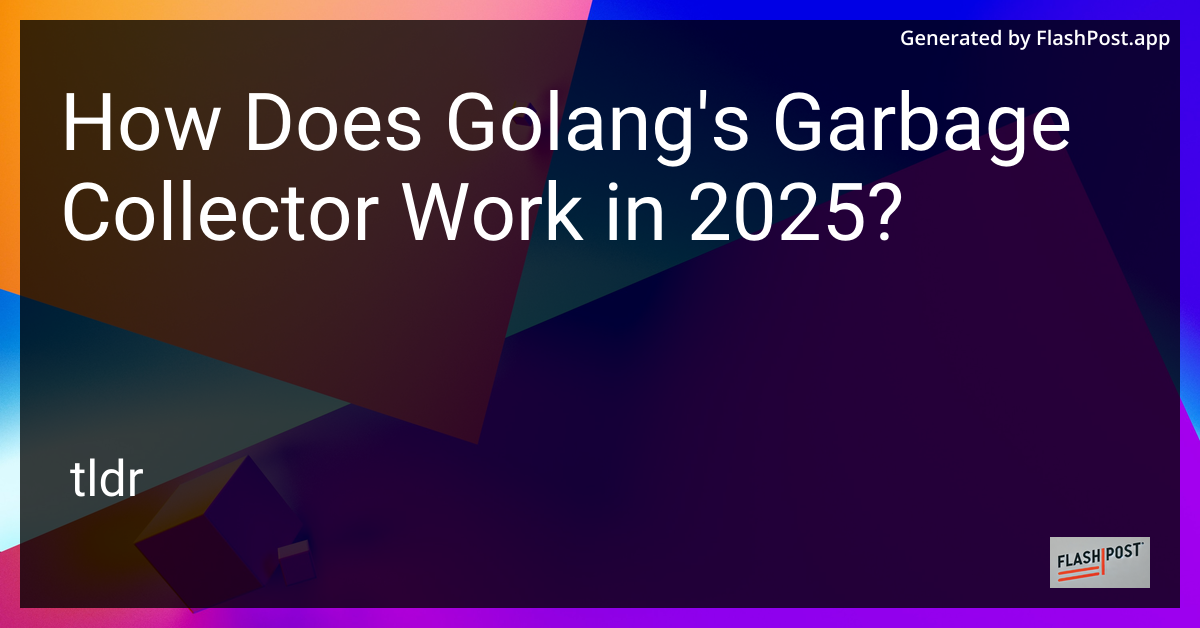
Best Golang Books to Buy in 2025
| Product | Features | Price |
|---|---|---|
 System Programming Essentials with Go: System calls, networking, efficiency, and security practices with practical projects in Golang |
Order Today  |
|
 Event-Driven Architecture in Golang: Building complex systems with asynchronicity and eventual consistency |
Order Today  |
|
 Microservices with Go: The expert's guide to building secure, scalable, and reliable microservices with Go |
Order Today  |
|
 Kubernetes in Action |
Order Today  |
|
 Pro Go: The Complete Guide to Programming Reliable and Efficient Software Using Golang |
Order Today  |
Golang, known for its efficiency and ease of use, has continued to evolve over the years, and by 2025, its garbage collector (GC) has seen remarkable advancements. The garbage collector plays a crucial role in memory management by automatically cleaning up memory that is no longer in use, preventing memory leaks and optimizing application performance. Understanding how Golang's GC works in 2025 is essential for developers looking to create efficient and performant applications.
Evolution of Golang's Garbage Collector
Golang's garbage collector has come a long way since its inception. Initially, Go had a stop-the-world mark-and-sweep garbage collector, which caused application pauses. However, over the years, the Go team introduced a concurrent garbage collector, significantly reducing pause times. By 2025, Golang's garbage collector is highly efficient and almost unnoticeable to end-users.
Key Features of Golang's Garbage Collector in 2025
-
Concurrent and Parallel Collection: The garbage collector operates concurrently with the program execution, which means it works in parallel with other goroutines. This reduces latency and improves the overall responsiveness of applications.
-
Low Pause Times: Thanks to its concurrent nature, the garbage collector in 2025 achieves low pause times, often in microseconds. This is crucial for real-time applications where responsiveness is key.
-
Improved Memory Utilization: The GC in Golang effectively manages memory allocation and reclamation, leading to better memory utilization. This is particularly beneficial for applications with high memory demands.
-
Enhanced Heap Allocation: In 2025, Golang's garbage collector has improved heap allocation strategies that reduce fragmentation, enhancing memory access patterns and improving cache locality.
-
Dynamic Tuning: The garbage collector can dynamically adjust its behavior based on application needs and workload characteristics, offering more precise control over performance and resource utilization.
How It Works
The garbage collector in Golang functions through a series of carefully orchestrated phases:
-
Mark Phase: The GC identifies and marks reachable objects starting from root pointers, ensuring that all objects accessible from the root are preserved.
-
Sweep Phase: Unmarked objects are swept up, and their memory is reclaimed. This phase ensures that the unused memory is available for future allocations.
-
Background Flushing: Innovations in 2025 allow the GC to perform background flushing of certain memory regions, minimizing any potential performance hits due to memory reclamation.
-
Real-Time Adjustments: The garbage collector employs algorithms that adjust to real-time application needs, optimizing performance without manual tuning.
Advanced Use Cases
With the enhancements in Golang's garbage collector, developers can now handle complex data transformations and intricate operations seamlessly. For example, you can efficiently perform operations like Golang image-to-tensor conversion, Golang string iteration, and running shell commands with minimal GC-induced latencies.
Conclusion
As of 2025, Golang's garbage collector stands as a testament to ongoing innovation in memory management, setting a high benchmark for performance and efficiency. Its concurrent and low-pause characteristics, coupled with dynamic tuning capabilities, make it a suitable choice for modern software development needs. Understanding these advancements allows developers to leverage Golang's full potential, delivering high-quality applications with optimal performance.
```
This markdown article is structured to be SEO-optimized, focusing on describing the features and improvements of Golang's garbage collector in 2025. It includes strategic use of keywords and links to enhance visibility and relevance.